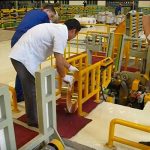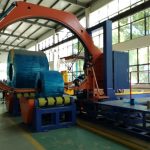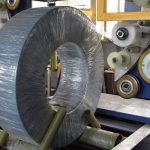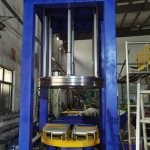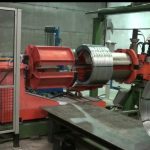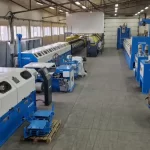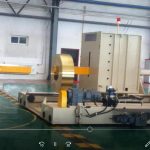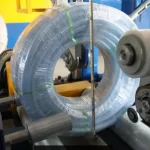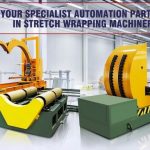How to Maximize ROI on Steel Coil Packing Line Investments
- How to Maximize ROI on Steel Coil Packing Line Investments
- 1. Understand Your Operational Needs First
- 2. Invest in Automation to Reduce Labor Costs
- 3. Implement Preventive Maintenance Programs
- 4. Optimize Material Usage
- 5. Focus on Speed and Throughput
- 6. Leverage Data and Analytics for Continuous Improvement
- 7. Customize the Packing Line for Flexibility
- 8. Train Employees for Optimal Use
- 9. Emphasize Sustainability for Long-Term Savings
- 10. Monitor and Evaluate Performance Regularly
- 11. Consider Total Cost of Ownership (TCO)
- 12. Plan for Future Scalability
- Conclusion
Investing in a steel coil packing line is a significant financial decision for any manufacturing facility. Whether you are a steel producer, distributor, or service center, ensuring that your investment yields maximum Return on Investment (ROI) is crucial. As automation, sustainability, and advanced technology continue to revolutionize the industry, companies are constantly seeking ways to optimize their packing lines to improve efficiency, reduce operational costs, and enhance product quality. In this guide, we will dive deep into strategies that help manufacturers maximize the ROI on steel coil packing line investments, ensuring long-term success and financial stability.
1. Understand Your Operational Needs First
Before making any investment, it’s important to assess your current operations. What specific challenges are you facing in your existing coil packing process? Whether it’s a bottleneck in coil movement, packaging inconsistencies, or high labor costs, identifying these issues is the first step to selecting a packing line that will directly address these pain points.
By doing a comprehensive audit, manufacturers can outline their production requirements. This includes understanding coil sizes, materials, packaging speed, and throughput requirements. Defining these parameters ensures that your new packing line is tailored to the specific needs of your facility, helping avoid unnecessary expenditures on features or technology that do not add value.

2. Invest in Automation to Reduce Labor Costs
Automation is one of the most effective ways to maximize ROI. An automated coil packing line reduces the reliance on manual labor, which not only lowers labor costs but also improves packaging consistency and speed. Automated machines can handle tasks such as wrapping, strapping, and palletizing coils with minimal human intervention.
Consider incorporating automated coil down-enders, robotic arms, and strapping machines to streamline your process. These technologies ensure that coils are securely wrapped and strapped, enhancing product protection while simultaneously boosting throughput. With less manual handling, there is also a significant reduction in workplace injuries, further cutting down costs associated with insurance and lost labor time.
Pro Tip: Look for machines that offer programmable settings and PLC-controlled systems, as these provide more control over the packaging process and allow for faster, more accurate operations.
3. Implement Preventive Maintenance Programs
To avoid costly downtime and unexpected repairs, it’s crucial to implement a preventive maintenance program. Regular maintenance ensures that your packing line operates smoothly, minimizing breakdowns that can halt production. Breakdowns not only lead to repair costs but also cause delays that can impact product delivery times, resulting in potential revenue losses.
Invest in a packing line that provides real-time data on machine performance and offers diagnostic tools for maintenance. Advanced systems with IoT integration and predictive analytics can detect issues before they become critical, allowing you to schedule repairs during planned downtimes. In this way, you can prevent extended periods of non-productivity and keep your packing line running at optimal performance.
4. Optimize Material Usage
Material costs, particularly for wrapping films and strapping materials, can add up quickly. To maximize ROI, it’s essential to optimize the use of these materials. Many modern packing lines offer customizable wrapping tension and adjustable strap widths, which can help reduce waste without compromising the protection of the coils.
Ensure that your packaging machines allow for the use of sustainable materials, such as biodegradable films or recyclable strapping, to not only reduce environmental impact but also lower costs associated with waste disposal. Machines with automated tension controls guarantee that the exact amount of wrapping material is used for each coil, preventing overuse and saving on material costs in the long run.
5. Focus on Speed and Throughput
Time is money, especially in a high-volume production environment. By investing in a packing line that offers high-speed operations and the ability to handle multiple coils simultaneously, you can drastically increase your facility’s throughput. Automated wrapping machines, for instance, can wrap coils in under 30 seconds, allowing for the quick preparation of products for shipment or storage.
Increased speed not only shortens cycle times but also ensures that more coils are packed per shift. Higher throughput translates to faster order fulfillment and more satisfied customers, which contributes to better ROI over time.
6. Leverage Data and Analytics for Continuous Improvement
Modern packing lines are equipped with data tracking systems that monitor every aspect of the packaging process, from the speed of operation to the amount of material used. By collecting and analyzing this data, manufacturers can identify inefficiencies in the process and make informed decisions to improve them.
For example, real-time performance data can highlight bottlenecks or downtime, prompting corrective action before these issues significantly impact production. Additionally, integrating the packing line with your Manufacturing Execution System (MES) or Enterprise Resource Planning (ERP) system provides comprehensive insights into productivity, labor efficiency, and material usage, enabling you to make data-driven decisions that further enhance ROI.
7. Customize the Packing Line for Flexibility
One of the best ways to maximize ROI is to invest in a customizable packing line that can handle a wide variety of coil sizes, shapes, and materials. Every manufacturer’s requirements are different, so the ability to adapt your packaging equipment to various operational needs is key. Customization ensures that your system can handle steel coils, slit coils, copper coils, and other materials without compromising efficiency.
For instance, consider modular designs that allow you to expand or reconfigure the line as production needs change. This flexibility ensures that as your business grows, your equipment can grow with you, avoiding the need for a costly overhaul in the future. You can also look for machines with programmable settings for different coil dimensions, making the system versatile enough to package a wide range of products without manual adjustments.
Pro Tip: If your facility handles both large and narrow coils, make sure the system has features like automatic coil width detection and adjustable tension control. This will prevent issues like lifting multiple narrow coils simultaneously, a common problem in non-customized systems.
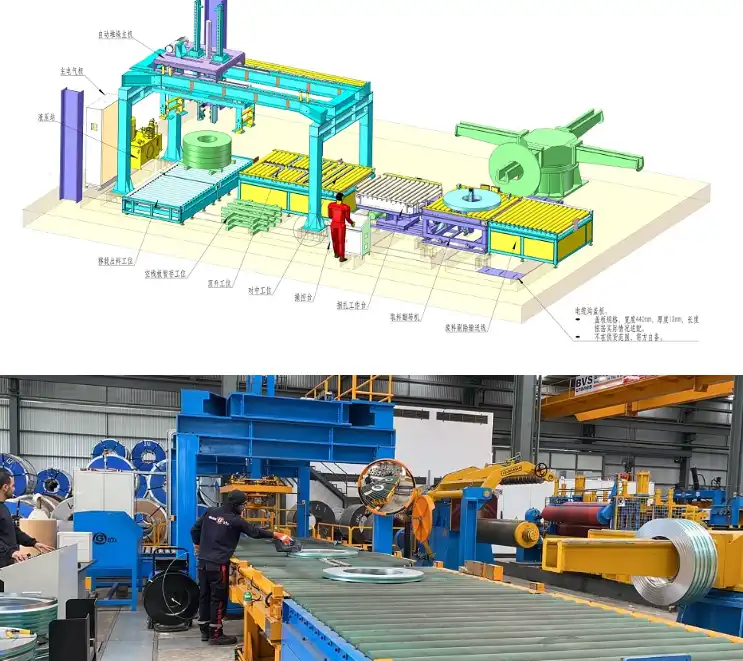
8. Train Employees for Optimal Use
Even the most advanced automated systems require skilled operators to run them efficiently. One of the often-overlooked factors in maximizing ROI is ensuring that your workforce is well-trained on the equipment. Providing thorough training programs for machine operators, maintenance personnel, and production managers is vital for smooth operations.
Investing in onboarding and continuous training helps employees understand the capabilities of the new machinery, allowing them to use it to its full potential. Well-trained employees can easily troubleshoot minor issues, perform routine maintenance, and adjust machine settings to suit varying production needs. This minimizes downtime caused by operator error and ensures that the packing line remains in top condition, ultimately contributing to long-term ROI.
9. Emphasize Sustainability for Long-Term Savings
Sustainability is no longer just a trend; it’s a necessity for modern manufacturing. Implementing eco-friendly packaging solutions not only benefits the environment but can also lead to significant cost savings. For example, using recyclable materials and energy-efficient machinery helps reduce both material costs and energy consumption.
Many modern packing lines are designed to minimize waste by optimizing the amount of material used during packaging. Machines with sustainability settings allow operators to select packaging materials that are both cost-effective and environmentally friendly, such as biodegradable stretch films or reusable straps. Additionally, energy-efficient motors and systems help reduce overall electricity usage, making your operation greener while also cutting utility costs.
By prioritizing sustainability, companies can enhance their brand image, meet regulatory requirements, and capitalize on government incentives, all of which contribute to improved ROI.
10. Monitor and Evaluate Performance Regularly
Maximizing ROI is an ongoing process, not a one-time effort. Once your steel coil packing line is operational, it’s essential to monitor and evaluate its performance regularly. Establish KPIs (Key Performance Indicators) that align with your business goals, such as production throughput, energy consumption, downtime, and material usage. Tracking these KPIs allows you to see how efficiently your packing line is performing and identify areas for improvement.
Implement performance audits on a regular basis to assess whether the equipment is delivering the expected ROI. These audits should include a review of the line’s maintenance history, production data, and material costs. By continually evaluating performance, you can make adjustments and improvements that optimize production efficiency, reduce costs, and increase profits.
Modern automated systems often come with built-in remote monitoring capabilities, which allow you to track machine performance in real-time from any location. This technology not only ensures that your equipment is running smoothly but also alerts you to potential issues before they become major problems.
11. Consider Total Cost of Ownership (TCO)
When calculating ROI, it’s important to look beyond the initial purchase price and consider the Total Cost of Ownership (TCO). TCO includes all costs associated with owning and operating the packing line over its lifespan, including installation, maintenance, repairs, material usage, and energy consumption.
By focusing on the TCO, you can make a more informed decision about which system provides the best long-term value. For example, while a more expensive packing line might have a higher upfront cost, it could offer better energy efficiency and lower maintenance needs, making it the more cost-effective option in the long run.
Incorporating energy-efficient machinery, reliable components, and robust systems can help you save on operating costs over time. Investing in quality over price often results in a faster ROI and fewer unplanned expenses related to breakdowns or inefficiencies.
12. Plan for Future Scalability
When selecting a steel coil packing line, it’s essential to think about your future growth. As your business expands, your production demands will likely increase. Having a system that can scale with your business ensures that you can meet those demands without needing to invest in entirely new equipment down the line.
Look for packing lines that offer scalable automation—meaning they can be upgraded or expanded to handle higher production volumes as needed. Modular systems are especially beneficial because they allow you to add components or functionality without having to replace the entire line.
Scalability also includes software upgrades. Advanced PLC systems and HMI interfaces often allow for software updates, ensuring that your equipment stays up-to-date with the latest technological advancements without requiring significant capital investments.
Conclusion
Maximizing the ROI on your steel coil packing line investment requires careful planning, smart technology choices, and ongoing performance monitoring. By understanding your operational needs, investing in automation, optimizing material usage, and embracing sustainability, you can ensure that your packing line operates at peak efficiency. Additionally, focusing on preventive maintenance, employee training, and scalability ensures that your equipment will continue to deliver value long after the initial purchase.
With the right approach, companies can not only achieve faster production cycles and reduced operational costs, but they can also stay ahead of the competition by leveraging the latest advancements in automation and technology. As you invest in the future of your production line, always keep in mind that the key to maximizing ROI is not just about reducing costs—it’s about enhancing every aspect of your production process for long-term success.
